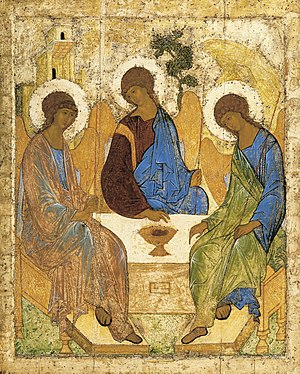| Andrei Rublev's Trinity, representing the Father, Son and Holy Spirit in a similar manner. (Photo credit: Wikipedia) |
Here is a sample of what McLaren wrote:
At the heart of Social Trinitarianism is the concept of perichoresis, which images God as a dynamic unity-in-community of self-giving persons-in-relationship. The Father, Son, and Spirit in this view are not three independent units (or monads) eternally bound together in a larger unity. Nor is God one independent unit with three identical parts. Rather, each person exists in dynamic social relationship with the others, and God is the relational unity in which they relate.
Similarly, the being of one person of the Trinity is not independent of the being of the others, so that one could be subtracted and the other two would stand. Nor does the being of one person stand over against the being of the others so the Father could be defined as “not the Son or the Spirit” or the Spirit as “not the Father or the Son,” and so on. Rather, the very idea of person — whether applied to human beings or to the Father, Son, and Holy Spirit — is redefined in Social Trinitarianism as “being in relationship.” A person’s relationships with the others, in other words, aren’t an accessory to the person who exists apart from them. Those relationships are what and who that person is, and that person cannot be said to exist apart from those relationships. Being, then, for God as for us, means interbeing, being in relationship, so the three persons of the Holy Trinity are not merely one with each other: they are one in each other.
...

